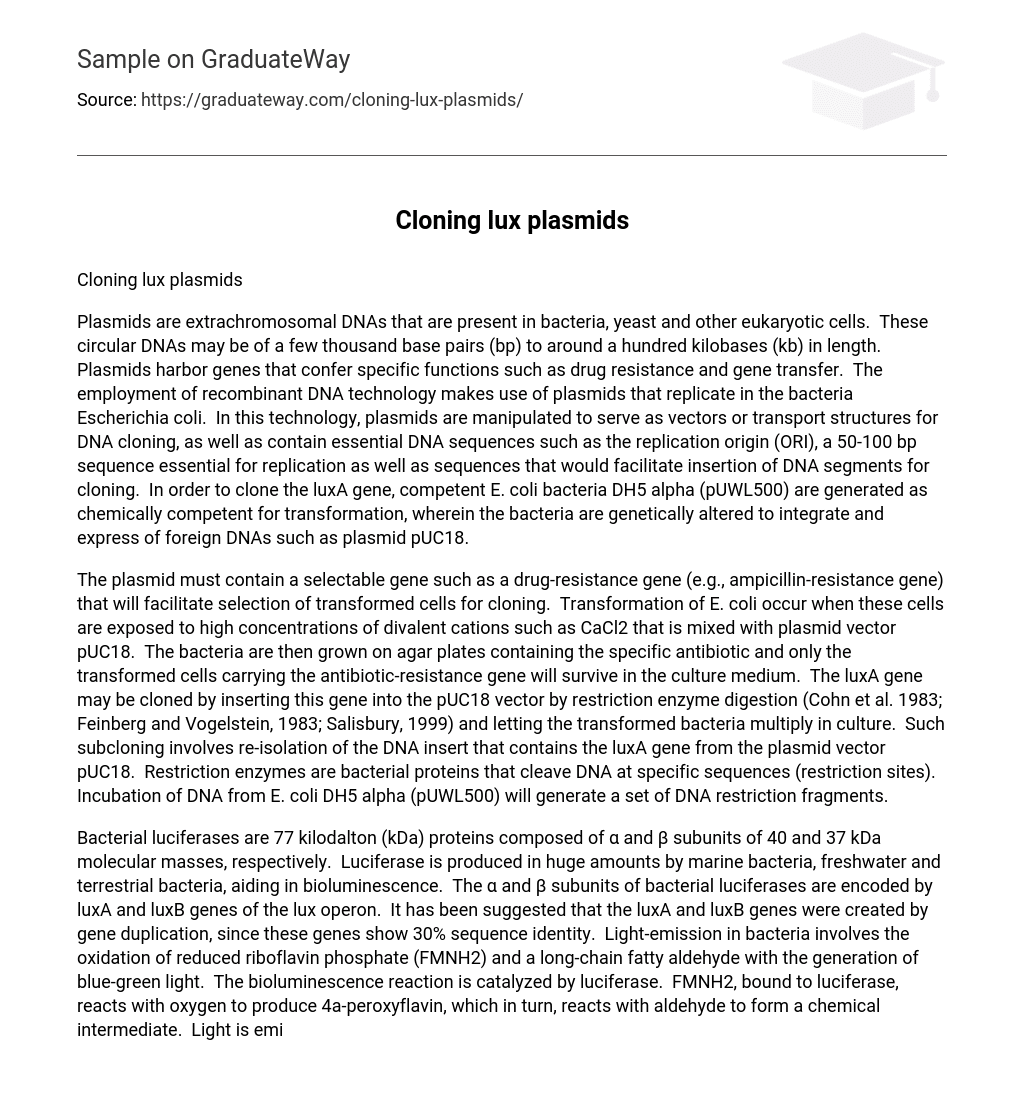Plasmids are extrachromosomal DNAs that are present in bacteria, yeast and other eukaryotic cells. These circular DNAs may be of a few thousand base pairs (bp) to around a hundred kilobases (kb) in length. Plasmids harbor genes that confer specific functions such as drug resistance and gene transfer. The employment of recombinant DNA technology makes use of plasmids that replicate in the bacteria Escherichia coli. In this technology, plasmids are manipulated to serve as vectors or transport structures for DNA cloning, as well as contain essential DNA sequences such as the replication origin (ORI), a 50-100 bp sequence essential for replication as well as sequences that would facilitate insertion of DNA segments for cloning. In order to clone the luxA gene, competent E. coli bacteria DH5 alpha (pUWL500) are generated as chemically competent for transformation, wherein the bacteria are genetically altered to integrate and express of foreign DNAs such as plasmid pUC18.
The plasmid must contain a selectable gene such as a drug-resistance gene (e.g., ampicillin-resistance gene) that will facilitate selection of transformed cells for cloning. Transformation of E. coli occur when these cells are exposed to high concentrations of divalent cations such as CaCl2 that is mixed with plasmid vector pUC18. The bacteria are then grown on agar plates containing the specific antibiotic and only the transformed cells carrying the antibiotic-resistance gene will survive in the culture medium. The luxA gene may be cloned by inserting this gene into the pUC18 vector by restriction enzyme digestion (Cohn et al. 1983; Feinberg and Vogelstein, 1983; Salisbury, 1999) and letting the transformed bacteria multiply in culture. Such subcloning involves re-isolation of the DNA insert that contains the luxA gene from the plasmid vector pUC18. Restriction enzymes are bacterial proteins that cleave DNA at specific sequences (restriction sites). Incubation of DNA from E. coli DH5 alpha (pUWL500) will generate a set of DNA restriction fragments.
Bacterial luciferases are 77 kilodalton (kDa) proteins composed of ? and ? subunits of 40 and 37 kDa molecular masses, respectively. Luciferase is produced in huge amounts by marine bacteria, freshwater and terrestrial bacteria, aiding in bioluminescence. The ? and ? subunits of bacterial luciferases are encoded by luxA and luxB genes of the lux operon. It has been suggested that the luxA and luxB genes were created by gene duplication, since these genes show 30% sequence identity. Light-emission in bacteria involves the oxidation of reduced riboflavin phosphate (FMNH2) and a long-chain fatty aldehyde with the generation of blue-green light. The bioluminescence reaction is catalyzed by luciferase. FMNH2, bound to luciferase, reacts with oxygen to produce 4a-peroxyflavin, which in turn, reacts with aldehyde to form a chemical intermediate. Light is emitted during the oxidation reaction.
The lux operon is a structural organization of genes that regulates the production of luminescent proteins through positive and negative feedback loops (Mancini et al. 1988). The lux operon consists of pluxR, luxR and luxI genes. The luxI protein is responsible for the autoinducer synthesis when lactone levels in the environment are high. When a sufficient amount of luxI accumulates, it interacts with the luxR protein that would stimulate transcription of the luxI and other lux structural genes. This transcription would then lead to more production of luxI protein.
References
Cohn, D.H., Ogden, R., Abelson, J., Baldwin, T., Nealson, K., Simon, M. and Mileham, A.J. (1983): Cloning of the Vibrio harveyi luciferase genes: Use of a synthetic oligonucleotide probe. Proc. Natl. Acad. Sci. USA 80:120-123.
Feinberg, A.P. and Vogelstein, B. (1983): A technique for radiolabeling DNA restriction endonuclease fragments to high specific activity. Anal. Biochem. 132:6-13.
Mancini, J., Boylan, M., Soly, R., Graham, A. and Meighen, E. (1988): Cloning and expression of the Photobacterium phosphoreum luminescence system demonstrates a unique lux gene organization. J. Biol. Chem. 263:14308-14314.
Salisbury, V., Pfoestl, A., Wiesinger-Mayr, H., Lewis, R., Bowker, K.E. and MacGowan, A.P. (1999): Use of a clinical Escherichia coli isolate expressing lux genes to study the antimicrobial pharmacodynamics of moxiflacin. J. Antimicrob. Chemo. 43:829-832.





